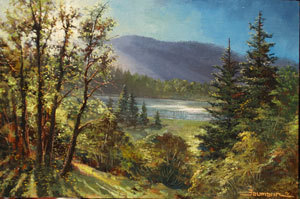I woke this morning with the feeling that something had changed. The air felt a little crisper, the sky looked a little darker and I could smell the earthy scent of leaves scattered on the ground in the woods. Yes, this is the feeling of fall, my favorite time of year! To celebrate the season, this year I am offering a September workshop that includes painting outdoors with a focus on Composition.
An important element in a painting is a good compostion which includes line, balance, movement, abstract form and many other details that are needed to create a great painting. Composition combined with other aspects of painting helps artists achieve their goals of creating pictorial unity. To do this, one must understand what to include and exclude in a painting and how to focus the viewer’s attention on what the artist wants the viewer to experience.
A good painting requires the effective use of the concept, variety, rhythm, repetition, unity, balance and harmony in its composition. The first step to achieve this begins with an accurate drawing of the subject or scene that also includes the relative values and potential colors to be used in the painting.
When you begin a painting, the first thing to consider is if the subject is worth while. Is there something about what you are painting that will enhance or educate the viewer’s experience? Does it wake up the viewer’s mind and go beyond the mere making of a picture? Sometimes selecting subjects that are simple are better then overly complicated views.
Try to find a subject that has large masses or chunks. Then, by squinting your eyes, you will be able to identify the relative values of the masses in your painting, and ultimately see four or five value planes which form the foundation of your composition. Artists often start by painting these chunks of value instead of painting the landscape’s details or sky. Once the value chunks are painted in, the artist can open his eyes a bit more and draw the subtle details in each chunk. At this time, color is not a concern as long as the rules of aerial prospective are observed, (things get lighter as they recede into the distance.) The effectiveness of large, simple masses produce a direct and immediate structure in a painting, and the result creates appealing and striking arrangements of masses and designs that inspire the viewer.
Painting requires practice that is ongoing throughout the life of an artist. Every journey begins with the first step, and I invite you to come to Mt. Shasta for an experience of a life time. Fall workshops at The Grand View Ranch are exceptional. Autumn is a special season when thousands of dogwoods and oak trees change their green summer foliage to orange and golden yellows, and the sun begins and ends lower on the horizon extending its shadows onto the landscape making it the most perfect time to paint on location.
During every workshop I challenge my students to stretch their comfort levels and learn new painting techniques and applications. In this way, students have opportunities to enhance the way they see and paint more effectively on location.

